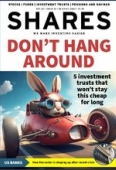Archived article
Please note that tax, investment, pension and ISA rules can change and the information and any views contained in this article may now be inaccurate.
A slowing US economy and sticky inflation leaves the Fed little choice

The US Federal Reserve’s unenviable task of bringing down inflation without crashing the economy got even trickier in March following the mini banking crisis. For now, at least, the worst of the turmoil in the financial sector seems to be over.
Nevertheless, the prospect of tighter bank lending standards and falling credit availability which was evident before the collapse of Silicon Valley Bank complicates the Fed’s job.
One of the key worries for Fed chair Jerome Powell is that inflation expectations become embedded in the economy which makes it harder to bring inflation down to target.
One of several inflation gauges used by the central bank to measure expectations is The University of Michigan inflation household expectations survey and Friday’s (14 April) report didn’t make for happy reading.
The one-year inflation outlook surged from 3.6% at the end of March to 4.6% which means consumers expect inflation to remain elevated and well above the Fed’s 2% target.
Expectations for inflation over the next five years were unchanged at 2.9%, still materially above the Fed’s target.
Meanwhile consumer sentiment readings from the same survey came in higher than expected for April although the prior month was revised lower.
WHEN TO STOP TIGHTENING?
One of the risks to the Fed’s aggressive tightening in monetary policy, which has seen interest rates increase from virtually zero to almost 5% in the space of a year, is that it could be inadvertently tightening into a slowing economy, a view shared by economist and Allianz adviser Mohamed El-Erian.
In other words, ‘long and variable lags’ associated with monetary tightening could yet come back to bite the Fed. One unhelpful sign in this regard is the latest retail sales data (14 April) which showed volumes decreasing twice as fast as expected.
The Department of Commerce said seasonally adjusted retail sales dropped 1% month-on-month compared with 0.5% expected by economists. Softness was seen in all categories with auto sales falling 1.6%, gasoline station sales down 5.5%, electronics down fell 2.1% and clothing declining by 1.7%.
The second consecutive monthly drop in retail sales suggests the surge registered in January was a one-off related to unusually mild weather and seasonal adjustments.
Despite conflicting data, the Fed is expected to press ahead and increase rates by a quarter of a percentage point at its next meeting on 3 May according to the CME FedWatch tool.
The latest minutes (12 April) from the FOMC (Federal Monetary Open Market Committee) meeting on March 22 revealed the bank’s economists are now expecting a mild recession sometime later this year.
Important information:
These articles are provided by Shares magazine which is published by AJ Bell Media, a part of AJ Bell. Shares is not written by AJ Bell.
Shares is provided for your general information and use and is not a personal recommendation to invest. It is not intended to be relied upon by you in making or not making any investment decisions. The investments referred to in these articles will not be suitable for all investors. If in doubt please seek appropriate independent financial advice.
Investors acting on the information in these articles do so at their own risk and AJ Bell Media and its staff do not accept liability for losses suffered by investors as a result of their investment decisions.
Issue contents
Feature
Funds
Great Ideas
News
- Positive bank reports set S&P 500 on course for new highs
- Why Superdry shares are down almost 50% in one year
- A slowing US economy and sticky inflation leaves the Fed little choice
- What to expect from Sainsbury's results after Tesco's growth warning
- New record high for LVMH as Chinese demand returns
 magazine
magazine








